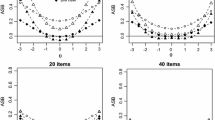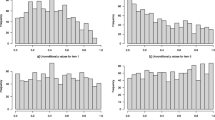Abstract
Given known item parameters, the bootstrap method can be used to determine the statistical accuracy of ability estimates in item response theory. Through a Monte Carlo study, the method is evaluated as a way of approximating the standard error and confidence limits for the maximum likelihood estimate of the ability parameter, and compared to the use of the theoretical standard error and confidence limits developed by Lord. At least for short tests, the bootstrap method yielded better estimates than the corresponding theoretical values.
Similar content being viewed by others
References
Bradley, R. A., & Gart, J. J. (1962). The asymptotic properties of ML estimators when sampling from associated population.Biometrika, 49, 205–214.
Chao, M. T. (1984).Generalized bootstrap methods (TRB-84-001). Taipei: Institute of Statistical Science, Academia Sinica, R.O.C.
Efron, B. (1979). Bootstrap methods: Another look at the jackknife.Annals of Statistics, 7, 1–26.
Efron, B. (1981a). Nonparametric standard errors and confidence intervals.The Canadian Journal of Statistics, 9, 139–172.
Efron, B. (1981b). Nonparametric estimates of standard error: The jackknife, the bootstrap and other methods,Biometrika, 68, 589–599.
Efron, B. (1982). The jackknife, the bootstrap, and other resampling plans.Society of Industrial and Applied Mathematics CBMS-NSF Monographs, 38.
Efron, B. (1984).Better bootstrap confidence intervals (Tech. Rep. No. 226). Palo Alto, CA: Stanford University, Department of Statistics.
Efron, B., & Tibshiran, R. (1986). Bootstrap methods for standard errors, confidence intervals, and other measures of statistical accuracy.Statistical Science, 17, 1–35.
IMSL (1987).International Mathematical and Statistical Libraries (Stat/Library Vol. I), User's Manual. Houston, TX: Author.
Lloyd, E. (1984). Maximum likelihood estimates. In E. Lloyd (Ed.),Handbook of applicable mathematics, Volume VI: Statistics (Part A) (pp. 283–354). New York: Wiley.
Lord, F. M. (1980).Application of item response theory to practical testing problems. Hillsdale, NJ: Erlbaum.
Lord, F. M. (1983). Unbiased estimators of ability parameters, of their variance, and of their parallel-form reliability.Psychometrika, 48, 233–245.
Miller, K. S. (1960).An introduction to the calculus of finite differences & difference equations. New York: Holt.
Parr, W. C. (1983). A note on the jackknife, the bootstrap and the delta method estimators of bias and variance.Biometrika, 70, 719–722.
Shenton, L. R., & Bowman, K. O. (1977).Maximum likelihood estimation in small samples. New York: Macmillan.
Tucker, L. R., Humphreys, L. G., & Roznowski, M. A. (1986).Comparative accuracy of five indices of dimensionality of binary items (Technical Report No. AD-A172110). Springfield, VA: National Technology Information Service.
Wainer, H., & Wright, B. D. (1980). Robust estimation of ability in the Rasch model.Psychometrika, 45, 373–391.
Author information
Authors and Affiliations
Rights and permissions
About this article
Cite this article
Liou, M., Yu, LC. Assessing statistical accuracy in ability estimation: A bootstrap approach. Psychometrika 56, 55–67 (1991). https://doi.org/10.1007/BF02294585
Received:
Revised:
Issue Date:
DOI: https://doi.org/10.1007/BF02294585




